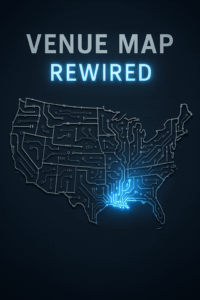
How EPA v. Calumet Shreveport Refining Rewired the Venue Map for Administrative Law
Visual Case Brief
By The One LawFirm | July 2025
When the U.S. Supreme Court decided EPA v. Calumet Shreveport Refining in May 2025, it didn’t just settle a venue squabble. It drew a sharp, defining line through the map of federal judicial review, making it crystal clear: if the EPA builds a regulatory policy on a national foundation, challengers can’t pick just any regional courtroom to fight it. They have to go straight to Washington.
At the heart of the dispute was a surprisingly technical, but fundamentally important, question: where should regulated industries go when they want to challenge an EPA decision under the Clean Air Act? Until Calumet, the answer was a frustrating mix of contradictory circuit rulings, agency discretion, and venue shopping.
This case changes all that.
A Refinery, a Rejection, and a National Rule
The dispute arose when Calumet Shreveport Refining and several other small refineries challenged the EPA’s 2022 denial of their exemption requests under the Renewable Fuel Standard (RFS). The RFS program requires refineries to blend biofuels like ethanol into gasoline, but small facilities can apply for hardship-based exemptions.
EPA, citing new economic analyses and a revised interpretation of hardship, denied over 100 such exemption petitions en masse. The agency argued that the hardship must be caused by the RFS compliance itself, and further claimed that small refiners typically pass those costs to consumers via price changes – meaning no real hardship existed.
The refineries sued in various regional circuits, but the Fifth Circuit broke ranks and took the case. It not only claimed jurisdiction but ruled against the EPA, criticizing the agency’s cost-pass-through assumptions. The EPA, sensing chaos and venue fragmentation, appealed to the Supreme Court.
The Supreme Court’s Two-Step Fix
Justice Clarence Thomas, writing for a 7-2 majority, introduced a now-definitive two-step test for deciding venue under the Clean Air Act:
1. Determine the Scope of the Action
Is the EPA action nationally applicable or locally/regional in effect? According to the Court, the EPA’s denial of each refinery’s petition was clearly local.
2. Is It Based on a Nationwide Determination?
Even if a decision affects only one party, if it’s rooted in a uniform national policy, then the whole action belongs in the D.C. Circuit.
In this case, the Court found that the EPA’s denials were fundamentally driven by a pair of national policies: the economic hardship interpretation and the cost-pass-through theory. As such, the D.C. Circuit was the only proper venue.
“EPA adopted a uniform legal and economic determination to presumptively resolve all SRE petitions,” the Court explained. “That determination, not the individual facts, was the primary driver of the agency’s decision.”
Interactive Table: CAA Venue Test Breakdown
| Question | Example Answer | Venue |
|---|---|---|
| Is the action nationally applicable on its face? | Yes (e.g., national ozone standard) | D.C. Circuit |
| Is the action regional/local on its face? | Yes (e.g., denial of one refinery’s exemption) | Regional Circuit unless step 2 applies |
| Is it based on a determination of nationwide scope or effect? | Yes (e.g., nationwide hardship test) | D.C. Circuit |
| Is the agency relying on localized reasoning? | Yes (e.g., individual SIP disapproval) | Regional Circuit |
Why It Matters
The implications of Calumet ripple far beyond a single refinery. For lawyers in administrative law, it redefines strategy. Agencies can consolidate litigation and reduce the risk of conflicting circuit rulings. Regulated industries, meanwhile, must recalibrate: the days of cherry-picking favorable venues may be over if the agency builds its action on a national policy.
“Venue is no longer a technicality; it’s a tactical threshold,” says one D.C. environmental litigator. “Calumet means you win or lose where the EPA sets the national rules.”
And those rules are increasingly vulnerable in the D.C. Circuit – especially post-Chevron, where courts no longer defer broadly to agency interpretations.
Contrast: Oklahoma v. EPA
In a same-day ruling, the Court decided Oklahoma v. EPA, another Clean Air Act case. Here, the EPA disapproved various State Implementation Plans (SIPs) related to ozone transport.
But unlike in Calumet, the Court ruled that these decisions were not driven by a national determination, but rather unique, state-by-state factors. Therefore, each state could sue in its own circuit.
| Case | Outcome | Venue |
| Calumet | National rationale dominant | D.C. Circuit |
| Oklahoma | State-specific facts dominant | Regional Circuits |
Looking Ahead
For the refining industry, Calumet is a double-edged sword. While it offers clarity and consistency, it also pulls future battles into a court often less sympathetic to industry challenges.
More broadly, the ruling will shape how agencies structure decisions. Expect more explicit declarations of nationwide scope when EPA wants to steer litigation to D.C., and more pushback from challengers when localized factors dominate.
For environmental law, administrative strategy, and industry regulation, Calumet is more than a refinery case. It’s the new GPS for Clean Air Act litigation.
Endnotes
EPA v. Calumet Shreveport Refining, LLC, 604 U.S. ___ (2025).
Clean Air Act, 42 U.S.C. § 7607(b)(1).
EPA SRE Denials (2022), 87 Fed. Reg. 29664 (May 16, 2022); 87 Fed. Reg. 39680 (July 1, 2022).
Oklahoma v. EPA, 604 U.S. ___ (2025).
Sidley Austin LLP, “Supreme Court Clarifies Venue for CAA Challenges,” May 2025.
ArentFox Schiff LLP, “Two Decisions, One Framework: Venue Under the Clean Air Act,” June 2025.
U.S. Supreme Court Opinion, EPA v. Calumet, majority slip opinion by Thomas, 2025.
SCOTUSblog Coverage, “High Court Reins in Circuit Splits on EPA Venue,” May 2025.
U.S. Department of Justice, Office of the Solicitor General, Brief in Support of Certiorari, 2024.
Legal Backgrounders and Amicus Briefs from Environmental and Industry Stakeholders, 2024.









